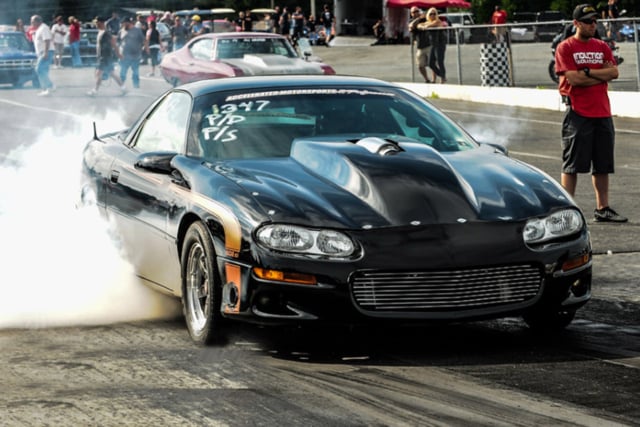 The fourth-generation Camaro experienced a difficult period in automotive manufacturing. As the evolution of power plants improved dramatically. The declining sales in the sports car market eventually gave way to the 2002 model year when the nameplate was put on “hiatus”. The brass at GM were smart enough to know that the sport coupe market would eventually return, and the Camaro needed to be prepared to meet that call. In this installment highlighting the Camaro engines we take a look at the engines from the fourth generation of the Camaro line.
The fourth-generation Camaro experienced a difficult period in automotive manufacturing. As the evolution of power plants improved dramatically. The declining sales in the sports car market eventually gave way to the 2002 model year when the nameplate was put on “hiatus”. The brass at GM were smart enough to know that the sport coupe market would eventually return, and the Camaro needed to be prepared to meet that call. In this installment highlighting the Camaro engines we take a look at the engines from the fourth generation of the Camaro line.
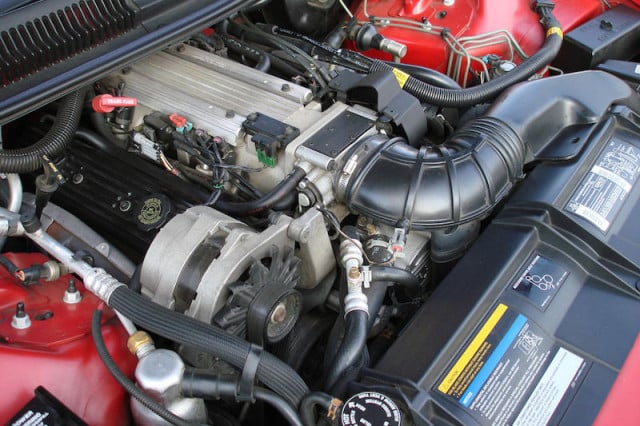
GM’s LT1 V8 engine was a new design of the small-block . Reverse cooling that began at the cylinder heads then went to the engine block was the major change in the Gen II small-block engines. Photo from wikipedia.org
1993 – Enter the LT1 Era
The fourth-generation Camaro started with a couple of new engine platforms in 1992. The L32 V6 engine was used in the Camaro and Firebird F-body cars with moderate success. Using the 3.4-liter (Gen I) design iron heads without splayed valves, this mill was rated at 160 hp.
The LT1 was initially used in the 1992 Corvette with some success, but the Camaro version was the recipient of a restrictive air cleaner and exhaust, so that it did not outperform the Corvette. The LT1 was a completely new small-block platform for GM, with the familiar 5.7 liter displacement and two-valves per cylinder push rod design.
The biggest change in this engine platform was the cooling system, which cooled the cylinder heads, and then the block before returning to the radiator. This “reverse flow” cooling system allowed the engine to run a higher compression ratio than the previous Camaro engines.
The LT1 was constructed with a cast-iron block and aluminum heads in the F-body Camaro. LT1 engines with cast-iron heads were also available for the B-body Caprice, and D-body Fleetwood autos. The Y-body Corvettes offered the LT1 with four-bolt main caps, which make those blocks a great replacement block.
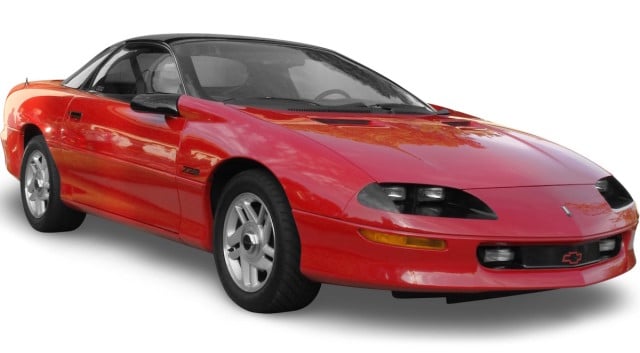
The 1993 Camaro launched the fourth generation of the nameplate. Photo from wikipedia.org
Beginning in 1993, the LT1 engine was operated by an engine control module (ECM) that controlled certain engine operations, rather than a Powertrain Control Module (PCM), which controls all engine functions. The PCM control would come a year later. Operating through the ECM, the LT1’s fuel was batch-fire injected, instead of the more economically operated sequential-port injection.
Because of the batch-fire injection, the Camaro LT1s have a unique intake-manifold casting, due to their fuel rails. All-in-all, the LT1 introduction into the fourth-generation Camaro meant a different platform, but an improvement over the previous engine series.
1993 Camaro Options:
- Base Coupe: L32 207ci
- Z28 Coupe: LT1 350ci
- Z28 Pace Car Replica: LT1 350ci
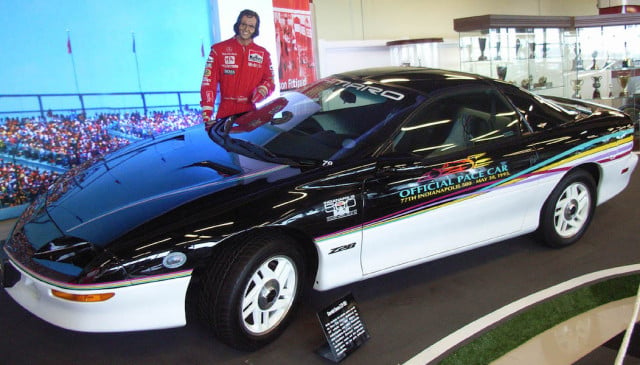
The 1993 Camaro Z28 was selected as the Indianapolis 500 pace car. Photo from wikipedia.org
1994 – Introducing the PCM
The six-cylinder L32 remained the base engine for the entry level Camaro, but the LT1 V8 was modified slightly. For 1994, the Camaro LT1 received the 4L60E transmission, which was the electronically controlled version of the 700R4. Fuel management switched from speed density to Mass Air Flow control (MAF) with a PCM that allowed the engines to start using sequential fuel injection. Fuel injectors were upgraded from 22 lbs/hr to 24 lbs/hr. The EPROM chips were soldered to the computer board in an effort to prevent their removal, and a three-wire heated O2 sensor replaced the previous single wire sensors. The PCM modules were programmable through the OBD1 diagnostic port.
Guided by EPA standards, the 1994 Camaro proved to be more efficient, yet it still lacked the eye-popping power that many personal coupe buyers were looking for. Despite the market woes, the Camaro soldiered on.
1994 Camaro Options:
- Base Coupe/Convertible: L32 V6 207ci
- Z28 Coupe/Convertible: LT1 350ci
1995 – Wish They All Could Be California Camaro
Returning with the same lineup for 1995, the V6 got a boost mid-year, when the Buick 3800 series II engine found their way into California base models. The California Camaro also benefited from dual catalytic converters for an added 10 horsepower gain. For the first time, California emission standards led to more horsepower.
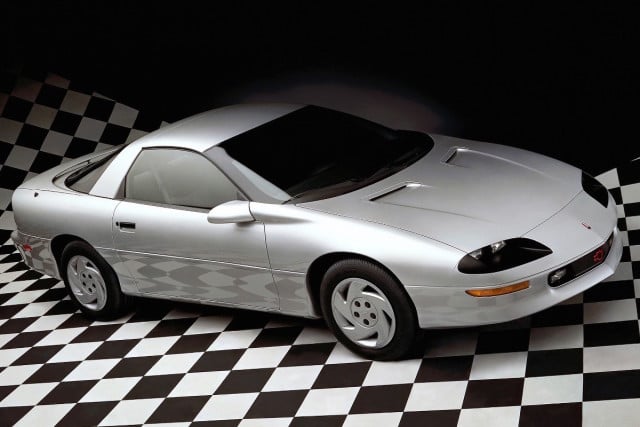
The 1995 Camaro found a horsepower increase with dual catalytic converters. Photo from gm.com
After the earlier Optispark distributor experienced problems due to moisture and condensation from heat, the 1995 vented Optispark distributors were introduced to help remove moisture. Earlier distributors can be modified with these vacuum vents to help with durability.
1995 Camaro Options:
- Base Coupe/Convertible: L32 V6 207ci
- Base Coupe/Convertible California models: L36 231ci
- Z28 Coupe/Convertible: LT1 346ci
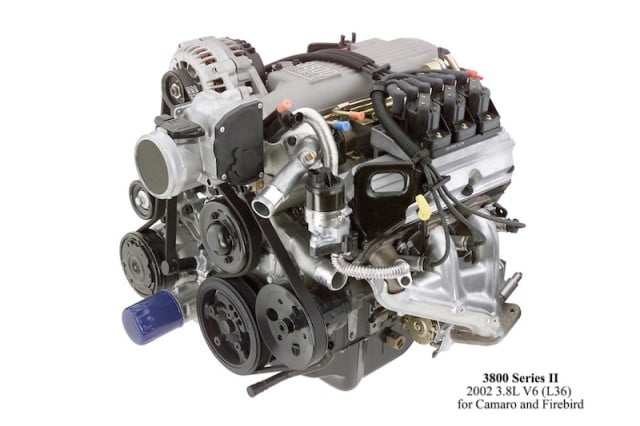
The L36 V6 engine became the base engine in 1995 and continued through the end of the fourth generation in 1992. Photo from www.flickr.com
1996 – OBD-II Becomes Standard
All car manufacturers complied with the new OBD-II standards, which helped auto mechanics and engine tuners alike. The success of the ’95 California Camaro with dual catalytic converters led to the Z28 Camaro receiving dual cats, and a revised y-pipe with a rear oxygen sensor to monitor catalyst efficiency. This also boosted the LT1’s rating to 285 hp from the previous 275 hp.
The 3.4-liter V6 disappeared from the Camaro options. A Camaro SS option package was available, but offered under limited production rules. The SS option cars were built by Street Legal Performance (SLP) under contract to GM. The SLP Camaro was rated at 305 horsepower (315 with optional exhaust), and featured a hood with a distinctive “ram-air” hood scoop. The SS also came with special badging and an upgraded suspension.
1996 Camaro Options:
- Base Coupe/Convertible: L36 231ci
- RS Coupe/Convertible: L36 231ci
- Z28 Coupe/Convertible: LT1 346ci
- SS Coupe/Convertible: LT1 346ci
1997- Final Year Of The LT1 V8 Engine
The LT1’s horsepower numbers continued to be rated at 285, due to the dual catalytic converters. The LT1 and L36 continued to be the standard engines for the Camaro, despite being the 30th anniversary year. A special anniversary package was available, but this was mainly an appearance package rather than a performance package.
Hugger Orange racing stripes, a white houndstooth cloth interior, and five-spoke wheels made up the package, along with seats that were marked with “30th Anniversary.” There are reports of 957 of these anniversary Camaro being built. Of those, 100 were built with the LT4 engine, which was the Corvette Grand Sport engine in 1996.
The Camaro lineup for 1997 was made up of three coupes and three convertibles, offered in the base, RS, or Z28 trim. A special RPO package (R7T), was prepared by SLP Engineering, and was available through dealers. This package included a 305 hp LT1 engine, a special hood with functional scoop and forced induction, and a revised suspension.
There were three ’96 Camaro Z28 coupes that paced the 1996 Indy Brickyard 400 race. Several 1997 festival replicas with the Indy Brickyard 400 trim were sold as used cars by Chevy dealers in 1997. All were built within the first 100 1997 VINs.
1997 Camaro Options:
- Base Coupe/Convertible: L36 231ci
- RS Coupe/Convertible: L36 231ci
- Z28 Coupe/Convertible: LT1 346ci
- SS Coupe/Convertible: LT1 346ci
- Z28 30th Anniversary Edition Coupe/Convertible: LT1 346ci
- SS 30th Anniversary Edition Coupe/Convertible: LT1 346ci
- Z28 1996 Brickyard 400 Pace Car Coupe: LT1 346ci
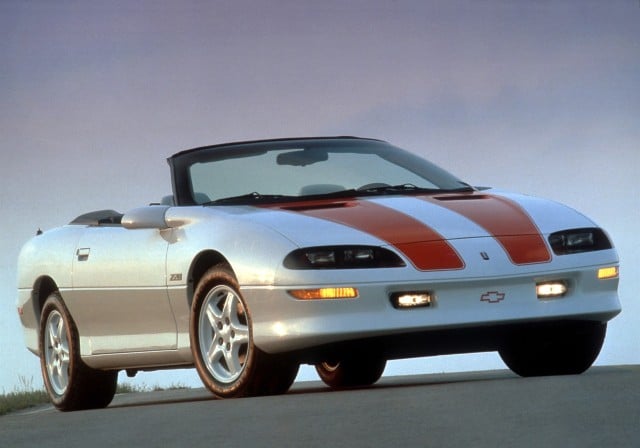
The 1997 30th anniversary Camaro brought some new life into the struggling nameplate. Photo from gm.com
1998 – Introducing the LS1
General Motors’ new LS-engine architecture found its way into the Camaro, in the form of the 1998 aluminum block LS1. The Gen III small-block replaced the LT1 in the Z28 models with a 305 horsepower rating. While the LS1 made its debut for Chevrolet in the 1997 Corvette at 345 rated horsepower, these are virtually the same engine, but many believe that GM under rated the Camaro’s LS1, to make the Corvette look better in the sports car market. The 1998 LS1 PCM is unique to 1998 cars only.
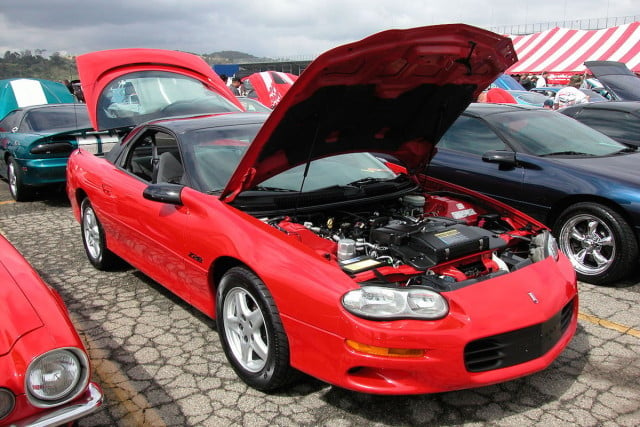
The 1998 Camaro Z28. Photo from wikipedia.org
This year also saw the inclusion of a new aluminum driveshaft in the driveline, as well as a completely new brake setup to handle the new engine. The Camaro SS was bumped up another level by SLP’s exhaust system, and was rated at 327 horsepower. The SS could be ordered in-house, where they were built at the St. Therese plant, and shipped to LaSalle, where SLP added the new hood and other SLP-exclusive components. The RS Camaro was dropped from the line.
1998 Camaro Options:
- Base Coupe/Convertible: L36 231ci
- Z28 Coupe/Convertible: LS1 346ci
- SS Coupe/Convertible: LS1 346ci
1999 – V6 Electronic Throttle Control
Very few changes happened for the 1999 Camaro, and of the changes that did take place, most were simple aesthetics and not performance related. Electronic throttle control was the big feature on the 3800 V6. Along with the electronic throttle control, the base Camaro with a V6 also gained traction control, while the Z28 and SS models added a limited-slip Torsen differential.
The LS1 engine also saw a change, with the valve covers switching to the center bolt style. The engine received smaller fuel injectors, and a bracket that mounted the ignition coils together, instead of mounting them separately. Coolant temperature gauges were replaced with a dummy gauge, and an “oil change” light was added to the instrument cluster. The oil-life monitor used an algorithm that evaluated the engine RPM, coolant temperature, and driven distances to determine oil change intervals.
1999 Camaro Options:
- Base Coupe/Convertible: L36 231ci
- Z28 Coupe/Convertible: LS1 346ci
- SS Coupe/Convertible: LS1 346ci
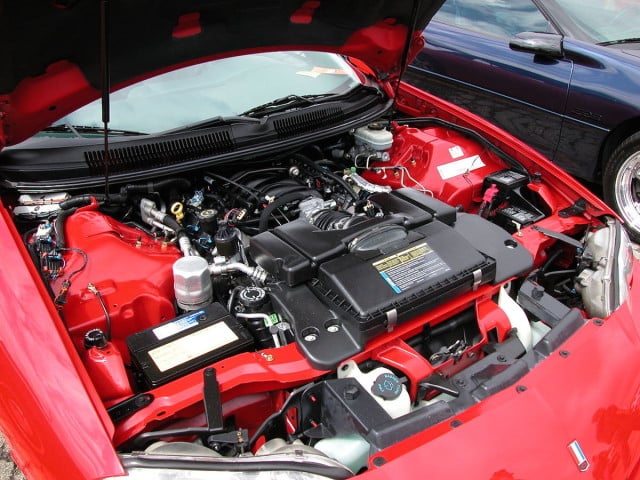
GM’s LS1 engine continued to be the base V8 engine in the Camaro. Photo from wikipedia.org
2000- The End Is In Sight
Changes for the 2000 Camaro were solely cosmetic. The addition of an optional metallic paint color was added, and the side mirrors were now painted body color, rather than the previous black color. As far as the engine packages were concerned, the 231ci V6 and 346ci LS1 continued with no changes for 2000.
2000 Camaro Options:
- Base Coupe/Convertible: L36 231ci
- Z28 Coupe/Convertible: LS1 346ci
- SS Coupe/Convertible: LS1 346ci
2001 – Getting Ready For The End
The Camaro’s normal production year was shortened, so the assembly plant could begin preparation and work on the 35th anniversary cars in 2002. This shortened production year would account for the lowest production numbers of the Camaro with only 29,009 units made.
Borrowing the 2001-2004 Corvette Z06 intake technology, the Z28 and SS Camaros were fitted with the intake manifold from the LS6 engine. The improved airflow was helped with a revised camshaft profile, and the elimination of the EGR system. Performance changes that were not engine related, included a new slave cylinder for the clutch assembly, and the addition of the LS6 clutch in Camaros with manual transmissions.
2001 Camaro Options:
- Base Coupe/Convertible: L36 231ci
- Z28 Coupe/Convertible: LS1 346ci
- SS Coupe/Convertible: LS1 346ci
- RS (SLP) Coupe/Convertible: L36 231ci
2002 – Going On Hiatus
The writing was on the wall, and the 2002 production year was going to be the last for the fourth-generation Camaro, and the last hurrah for the Camaro as a nameplate for an unspecified time. Knowing that 2002 was going to be the last year for the Camaro due to the model going into a “company defined hiatus”, understandably, there were no changes in the engine packages. All other changes were minimal, with most centering around the celebration of the 35th anniversary of the Camaro. Basically, the 2002 Camaro was a carryover from the 2001 model year.
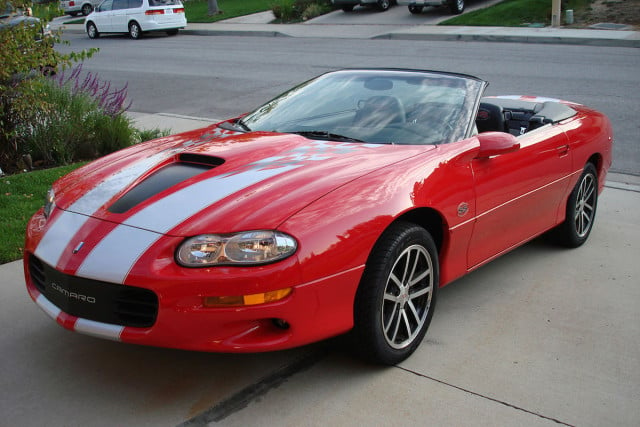
The 2002 Camaro SS convertible is a prime example of the last year of the era. Photo from wikipedia.org
It is rumored that a few LS1 Camaros left the factory with LS6 engine blocks, and these “factory freaks” were reported to pump out 60 more horsepower than advertised, for a massive 400 hp. The base V6 continued to serve the final model year with a five-speed transmission with overdrive as the standard, or a four-speed transmission with overdrive as an optional choice. The Z28 was equipped with the standard LS1 engine with a four-speed automatic with overdrive as the standard. Special anniversary packages were available, but the engine platforms and performance remained the same.
On August 27th of 2002, the St. Therese, assembly plant in Canada produced the very last Camaro, a red convertible that went directly into the GM Heritage Center’s collection. The plant officially closed forever on Thursday, August 29, 2002.
2002 Camaro Options:
- Base Coupe/Convertible: L36 231ci
- Z28 Coupe/Convertible: LS1 346ci
- Z28 SS 35th Anniversary Edition Coupe/Convertible: LS1 346ci
- SS Coupe/Convertible: LS1 346ci
- RS (SLP) Coupe/Convertible: L36 231ci



























